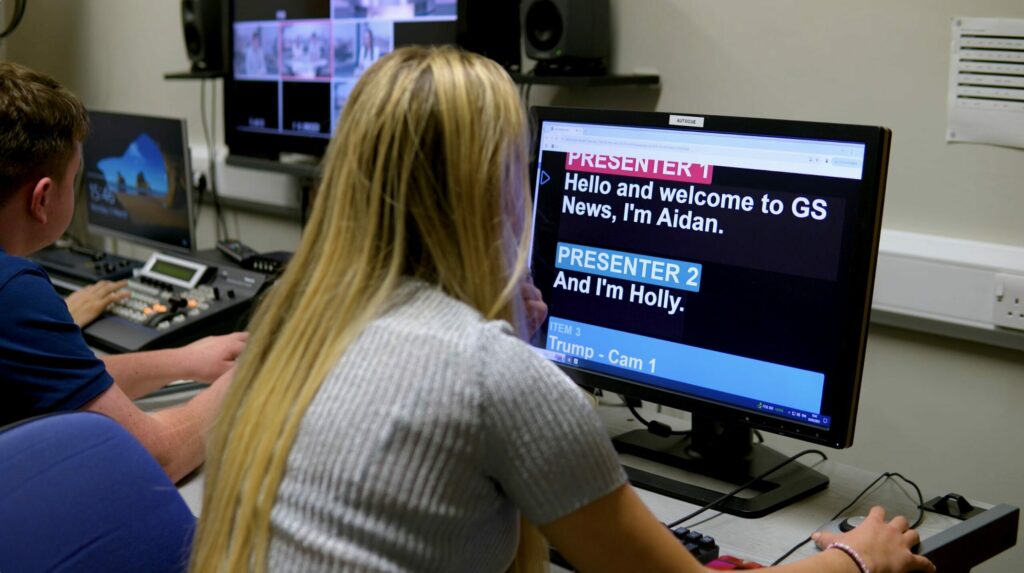Education
News Production: Glasgow Caledonian University
The Newsroom of Tomorrow: How GCU Students Use Cuez to Learn Live Production
For students in the broadcast journalism program at Glasgow Caledonian University (GCU), news day isn’t just a simulation, it’s a reality similar to that of a real news studio. From scripting and video editing to autocue operation and live gallery direction, they run the show from top to bottom. How? Cuez.
We were invited to get a sneak peek into a typical production day at GCU, where Cuez has become a key part of how students learn the ropes of live news production.

Building GS News from Scratch
With Cuez, GCU students do not just learn about news production in theory. They run the whole production, learning to think like producers. The software gives them full control over scripting, running order, video playback, camera cues, and presenter roles, all in one central platform.
In addition to theoretical learning opportunities, Cuez offers hands-on, real-life production experience. The platform is what production and newsrooms use in the real world of live productions.
“I’ve had a really easy experience using cuz I think it’s very straightforward, very simple, and it’s great to know that we’re using something that’s going to help us in the industry,” says one of the GCU students.
"Cuez allows the students to be able to build a TV news bulletin. It allows them to be able to look at the structure of the bulletin, and decide what order items are coming inside. Which presenters are presenting. Decide which cameras are being used. It also allows the individual students in the team to be able to write in, scripts for cues, writing scripts for underlings, and also upload video as well.
Angus Dixon, Programme Leader BA Multimedia Journalism
Easy to Pick Up, Hard to Let Go
What is one of the advantages that Cuez offers to GCU students? Production simplicity.
“It’s probably the easiest software I’ve ever used. You just log in, press a few buttons, and it’s ready to go in the gallery,” mentions one of the students.
As live and news productions evolve, and gallery set-ups become more advanced, Cuez is exactly the tool that can help make sense of the production process from start to finish, especially when one is just at the beginning of their broadcasting career. However, that simplicity doesn’t come at the cost of professionalism. On the contrary, it allows students to learn how to create a high-quality newscast, just like professionals do at the BBC and such.

Industry-Ready Experience
Training isn’t just about teaching students how to do the job, it’s also about meeting real industry expectations. That’s where the Broadcast Journalism Training Council (BJTC) comes in, helping universities like GCU align with standards set by organisations such as the BBC and ITN.
According to Angus Dixon, the Programme Leader, Cuez fits right into that vision:
“The BJTC acts as a bridge between industry and academia. They’ve been really happy with how Cuez helps our students get industry-ready.”
Isn’t that what truly matters? Not simply teaching the young talent the fundamentals of broadcasting, but also showing them how to practically apply that knowledge, so that once they enter the broadcasting world, they are industry-ready.

It’s efficient, it’s collaborative, and it has helped students to get industry ready."
Angus Dixon, Programme Leader BA Multimedia Journalism
Real Tools. Real Skills. Powered by Cuez.
Cuez has become more than just a tool at GCU, it’s now a vital part of how students learn to think, collaborate, and produce newscasts like professionals. From scripting and timing to video playback and gallery operation, students are getting the kind of experience that sticks with them long after graduation.
They’re not just learning how a show comes together—they’re learning how to lead it.
Cuez is one of the tools that helps educators do what they do best: prepare the next generation of journalists, producers, and media innovators for the real world.
Curious? Learn how Cuez can help your university programme here.


